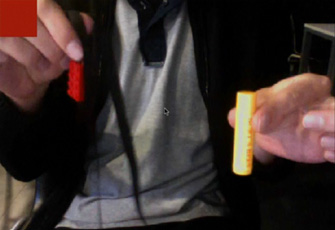-
var bufferSize:int = 20;
-
var blurAmount:Number = 20;
-
var motionColor:uint = 0xFF222222;
-
var pixelNum:int = 800 * 600;
-
-
var cam:Camera = Camera.getCamera();
-
-
cam.addEventListener(ActivityEvent.ACTIVITY, onActivityStart);
-
-
function onActivityStart(evt:ActivityEvent):void {
-
trace("start");
-
addEventListener(Event.ENTER_FRAME, onLoop);
-
cam.removeEventListener(ActivityEvent.ACTIVITY, onActivityStart);
-
}
-
cam.setMode(800,600,30);
-
-
var video:Video = new Video(800, 600);
-
video.attachCamera(cam);
-
-
var canvas:BitmapData = new BitmapData(800,600,false, 0x000000);
-
//addChild(new Bitmap(canvas));
-
var feed:BitmapData = new BitmapData(800,600,false, 0x000000);
-
addChild(new Bitmap(feed));
-
-
var prev:BitmapData = new BitmapData(800,600,false, 0x000000);
-
-
var thresh:BitmapData = new BitmapData(800, 600, true, 0xFF000000);
-
//addChild(new Bitmap(thresh));
-
var cm = new ColorMatrixFilter([0.3086,0.6094,0.082,0,0,0.3086,0.6094,0.082,0,0,0.3086,0.6094,0.082,0,0,0,0,0,1,0]);
-
-
var threshSamples:Vector.<uint> = new Vector.<uint>();
-
var samples:Vector.<uint> = new Vector.<uint>();
-
var pixelSampleRate:int = 10;
-
-
var shape:Shape = Shape(addChild(new Shape()))
-
-
-
-
function onLoop(evt:Event):void {
-
-
canvas.draw(video);
-
feed.draw(video);
-
-
canvas.draw(prev, null, null, BlendMode.DIFFERENCE);
-
canvas.applyFilter(canvas, canvas.rect, new Point(0,0), new BlurFilter(blurAmount, blurAmount, 1));
-
//canvas.applyFilter(canvas, canvas.rect, new Point(0,0), cm);
-
prev.draw(video);
-
-
thresh.fillRect(thresh.rect, 0x000000);
-
thresh.threshold(canvas, canvas.rect, new Point(0,0), ">=", motionColor, 0xFFFF0000, 0xFF00FF00);
-
-
threshSamples = thresh.getVector(thresh.rect);
-
-
var cols:Array = []
-
var index:int = 0;
-
for (var i:int = 0; i<pixelNum; i+=pixelSampleRate){
-
if (threshSamples[i] == 0xFFFF0000){
-
var col = feed.getPixel(i % 800, int(i / 800));
-
var r = col>> 16 & 0xFF;
-
var g = col>> 8 & 0xFF;
-
var b = col & 0xFF;
-
var sl = toHSB(r, g, b);
-
if (sl[0]> 60 && sl[1]> 30 && sl[1] <60){
-
cols[index++] = col;
-
}
-
}
-
}
-
-
if (cols.length> 0){
-
shape.graphics.clear();
-
shape.graphics.beginFill(cols[int(cols.length * Math.random())]);
-
shape.graphics.drawRect(0,0,100,100);
-
}
-
-
}
-
-
// this is from somewhere online, if I can find the link I'll post it
-
function toHSB(R, G, B):Array{
-
var H, S, L
-
var var_R = ( R / 255 ) //RGB from 0 to 255
-
var var_G = ( G / 255 )
-
var var_B = ( B / 255 )
-
-
var var_Min = Math.min( var_R, var_G, var_B ) //Min. value of RGB
-
var var_Max = Math.max( var_R, var_G, var_B ) //Max. value of RGB
-
var del_Max = var_Max - var_Min //Delta RGB value
-
-
L = ( var_Max + var_Min ) / 2
-
-
if ( del_Max == 0 ) //This is a gray, no chroma...
-
{
-
H = 0 //HSL results from 0 to 1
-
S = 0
-
}
-
else //Chromatic data...
-
{
-
if ( L <0.5 ) S = del_Max / ( var_Max + var_Min )
-
else S = del_Max / ( 2 - var_Max - var_Min )
-
-
var del_R = ( ( ( var_Max - var_R ) / 6 ) + ( del_Max / 2 ) ) / del_Max
-
var del_G = ( ( ( var_Max - var_G ) / 6 ) + ( del_Max / 2 ) ) / del_Max
-
var del_B = ( ( ( var_Max - var_B ) / 6 ) + ( del_Max / 2 ) ) / del_Max
-
-
if ( var_R == var_Max ) H = del_B - del_G
-
else if ( var_G == var_Max ) H = ( 1 / 3 ) + del_R - del_B
-
else if ( var_B == var_Max ) H = ( 2 / 3 ) + del_G - del_R
-
-
if ( H <0 ) ; H += 1
-
if ( H> 1 ) ; H -= 1
-
}
-
return [ int(S * 100), int(100 * L)]
-
}


